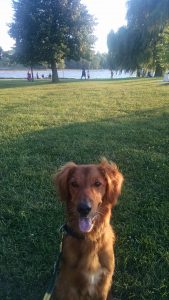Last weekend I went up to Cleveland to attend a judge’s seminar for AKC obedience/rally. I’ve intended to go for at least 10 years and never made it until now! I’m really glad I took the time to go. While judging AKC obedience/rally is not my goal – I do already judge other programs in both obedience and rally, plus Ohio 4-H dog judging is based off of AKC. And as a competitor – it’s good to know what the judges are really looking for.
The two from AKC (I never got their names?!) were excellent. They were organized and prepared. Their outline flowed very well. They had great video examples of some common errors – some intentionally set up and some that accidentally happened while they were filming. And most impressively – they handled some difficult discussions very well. The response was professional and then moved on very effectively. I want to have their skill!
Balance Between Written Rules and Judge’s Decisions:
 The competition obedience rules don’t outline everything that might happen and so there are places where judges have to make decisions on their interpretation of those rules. The presenters did a great job of outlining where rules are clear and some of the places where judges do have to make decisions. They allowed discussion from the audience at certain points and this was very valuable as it tended to be experienced judges making comments. Hearing their experiences and opinions was helpful to me – both to know that there are many places that are open to interpretation and to know that there are times that judges have a dilemma about how to score.
The competition obedience rules don’t outline everything that might happen and so there are places where judges have to make decisions on their interpretation of those rules. The presenters did a great job of outlining where rules are clear and some of the places where judges do have to make decisions. They allowed discussion from the audience at certain points and this was very valuable as it tended to be experienced judges making comments. Hearing their experiences and opinions was helpful to me – both to know that there are many places that are open to interpretation and to know that there are times that judges have a dilemma about how to score.
Logistics:
In several places, the team gave recommendations on how to improve the efficiency and flow of judging – they also referenced documents from the AKC such as this set of tools for rally judges. There were examples of score sheets. I wasn’t aware there were variations in score sheets that judges could use. There were examples of making the rule book more user friendly – such as cutting up inserts (updates to the rule book but just some single pages) and attaching them to the relevant sections within the book. On the obedience day we had a demonstration of all three typical obedience levels to show the ring flow, where to stand, how to set things up, how to train the stewards. Seeing this in action and the discussion that came up was so valuable.
When Things Aren’t Right at the Show:
Each day the presenters spent some time talking about what to do if a judge shows up and something at the show site is wrong. What if the rally signs aren’t there? What if the jump isn’t correct? What if the ring is too small? The judges must judge. They can’t refuse to do so and need to make things work. Hand write rally signs. Make the ring bigger. Delay the start by an hour to give the floor time to dry.
These kinds of things happen a lot with 4-H, though as it’s not as official as AKC – so we have flexibility to accommodate more generously than what is permitted in AKC. Knowing that sometimes things don’t go right at AKC events makes me feel a little better about some of the challenges that come up in other programs!
“It’s Just a Dog Show”
The presenters kept repeating this phrase. While judges should be professional, fair, and hold the standards – it’s also just a dog show. No one’s life is at stake. The events are important to exhibitors but it’s not the most important thing in the world and keeping this in perspective is important while judging or handling moments where exhibitors are not as happy or comfortable.
Some Other Things I Learned
- Wickets like used in agility measuring are not allowed to be used in rally/obedience.
- The Stand for Exam (novice) and handler distance from the broad jump are the two times the judge can tell the handler to move and that the handler is not in the correct spot.
- Many judges will set up and practice their rally courses prior to going to a trial.
I’m excited to be at an obedience trial next weekend and to be thinking about all of these things while being an exhibitor!